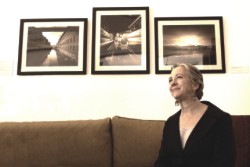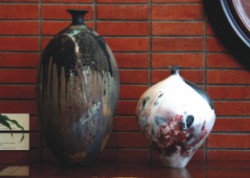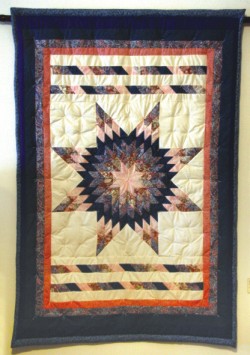Reflections
Art as a
Communicator
Aasha Mehreen Amin
The arts and craft of a civilisation have always worked as evidence of its existence and therefore seen as the most valuable witnesses of history. This is why works of art are considered the best communicators, transcending the barriers caused by difference in language, culture or religion. Lauren Kahea Moriarty a former US diplomat and the wife of the present US Ambassador to Bangladesh James F. Moriarty, feels that art is the best way to connect with people from different backgrounds, the easiest way to spark a conversation and the most tangible way to appreciate a culture and the hard work of people. It is also an important way to find similarities in cultures to provoke greater understanding and tolerance. A small collection of paintings, craft and photographs adorning the walls of her home in Gulshan will be exhibited on November 9 for invited guests as part of 'the Art in Embassies Program'. The practice started in 1964 whereby more than 3,500 original works of art loaned by US citizens or museums are displayed in the public rooms of some 180 US embassy residences all over the world. The idea is to give people of the country they are serving, a glimpse into American cultural heritage but they also give a hint into the personalities behind the diplomats whose vocation is so public.
Although the exhibits have been flown in all the way from the US from museums or from private collections the choice of the items on display have been made by the Moriarty couple and give away a little of their interesting backgrounds.
On display are a set of black and white photographs by Randolph Lagenbach taken in 1975 after the former Amoskeag Cotton Mill in Manchester New Hampshire was shut down and its machines scrapped. There is a picture called 'The Last Loom Fixers' a group of men who were part of the transition that one of the most powerful nations was going through. "We wanted to showcase Americans at work", says Lauren Moriarty, "and these pictures really spoke to us.
"When I saw the pictures I thought, this looked just like my husband and his pals in the 1970s. My husband grew up in a small town in Massachusetts and his first job was in a mill much like the one in the picture. He had to sweep the floor, tear rags and operate the machinery." Another more poignant picture is titled 'The Last Spinners', three elderly women workers of the mill on their last day of work. Interestingly, on the wall opposite these pictures are two photographs taken by two other photographers of Bangladeshi workers, a woman and a man, working at the looms of a mill. The intention is to show the similarities in the people of these two countries thousands of miles apart. Beginning in the early 1800s textile mills provided jobs for thousands of Americans including new immigrants and young women, much like our own garment factories have given employment to thousands of young Bangladeshi women and men.
This underlying theme of similarity has been quite intentional. There are the water colours of Hawaiian villages by Joseph Hauoli Dowson Sr., a beautiful Hawaiian quilt with flower motifs by late Hawaiian artist Meali'i Kalama and another hand-cut, machine sewn quilt by Ann Shaw, a traditional craft in the southern states of the US and clay pottery by Ramon Camarillo who will be coming to Dhaka to hold workshops with Dhaka University art students. The village homestead looks like a thatched hut in a Bangladeshi village and the quilts are similar to the painstakingly sewn nakshikantha that is integral to our own traditional craft. The former diplomat who is of Hawaiian origin (her father is Chinese Hawaiian and mother Irish) explains that traditional craftsmanship is still very much part of American culture and there are many people who despite their jet set corporate lives, have hobbies such as quilt-making or painting. She herself is fond of knitting apart from other hobbies such as hiking, trekking and running marathons.
"I love to visit places where I can watch people work, so I love factory visits," admits Lauren Moriarty, a former ambassador who is a successful career diplomat and has held different important positions of the US government, including the US Ambassador to the Asia-Pacific Economic Cooperation (APEC).
"Part of our culture is that whatever work we do there is dignity, we take pride in our work. I really appreciate people who take the trouble to make everyday things, say a pot or a chair, and make it pretty. So art is not just something on the wall but in everyday life." says Moriarty, who is an Economics graduate and has a masters in Law and Diplomacy from the Fletcher School of Law and Diplomacy under Tufts University.
 |
 |
Pua Mae'ole, c. 1980, French knot embroidery on flower motifs;
paisley print backing; cotton with polyester backing. Artist:
Meali ' i Kalama.
|
Lauren Kahea Moriarty in front of a display of historic photographs of a mill in New Hampshire about to be shut down
in the 70s by Randolph Lagenbach. |
Photo: Zahedul I Khan
 |
 |
Raku-fired clay pottery by Ramon Camarillo. |
Starburst Lap Quit, 2008 by Ann Shaw. |
Copyright
(R) thedailystar.net 2009 |
